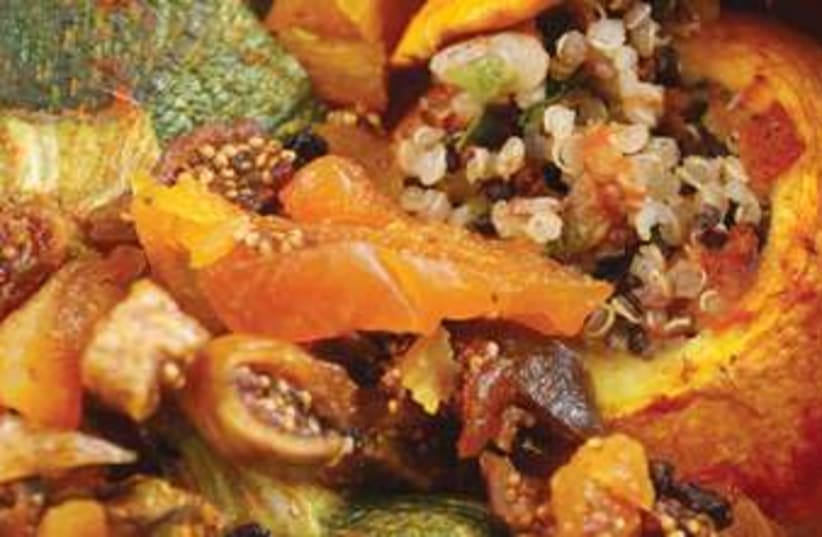✔ 2 Tbsp. extra-virgin olive oil ✔ 1 large onion, finely chopped ✔ 1 bay leaf ✔ 2 large cans whole tomatoes, pulverized ✔ 1 Tbsp. honey ✔ 2 cups water ✔ 1⁄2 cup dry red wine ✔ 1 tsp. dried basil ✔ 1 tsp. dried oregano ✔ 1⁄2 tsp. dried thyme ✔ 1⁄2 Tbsp. paprika ✔ Salt and freshly ground black pepper to tasteTo prepare the vegetables for stuffing, wash the potatoes and use a sharp knife to hollow out a large indentation, leaving a rim. (Alternatively, potatoes may be halved like boats.) Cut the top off the eggplant and hollow out the inside (or cut in half). Cut off a thin slice from the top of the tomatoes and onion and scoop out the flesh (may be added to the cooking sauce), leaving a firm rim to hold the stuffing. Slice about a centimeter off the top of the onion, and hollow out a bowl-shaped space.Cut a slice off the bottom so the onion will stand upright.Cut off the top and tail of the zucchini and cut into 3 pieces each. Hollow out each piece leaving a rim. Sprinkle the zucchini with salt and turn over on a rack to drain for 10 minutes. Drain, rinse and pat dry. Set all the vegetables aside, cut side down.Cut the top off the pears and use an apple-corer to scoop out the insides, leaving enough at the base so the filling will not escape (or cut in half, core and hollow-out only the base).Quinoa: Pour quinoa into a pot with the water and bring to a boil.Cover and cook over low heat for 10 minutes (or follow directions on package). Remove from heat and let stand, covered, till just barely warm. Fluff with a fork.Add the fresh herbs, onion, seasonings, dried fruit and pistachios to the quinoa and mix well with a fork.Stuff the vegetables and pears with the mixture and replace the lids.Sauce:Pour olive oil into a medium pot and sauté the onion 3-5 minutes until golden, stirring often. Add garlic and sauté a few seconds. Add the rest of the ingredients.Bring to a boil and cook over low heat for 20 minutes.Remove cover and cook 10-15 minutes till just thickened. Taste and adjust seasonings.Pour one-third of the sauce in the bottom of a large wide oven-proof pan and place the peppers standing up inside snugly (other vegetables like carrots may be used around the sides of the pot to keep the vegetables in place). Pour the remaining sauce around, cover and bake in a pre-heated 180º oven for 45 minutes.If the sauce is too thick, thin with a little boiling water.Follow @JPost_Lifestyle
Give quinoa a chance
Quinoa is not only for vegans anymore. Try this fantastic grain as a substitute for rice or as kosher-for-Passover stuffing.

✔ 2 Tbsp. extra-virgin olive oil ✔ 1 large onion, finely chopped ✔ 1 bay leaf ✔ 2 large cans whole tomatoes, pulverized ✔ 1 Tbsp. honey ✔ 2 cups water ✔ 1⁄2 cup dry red wine ✔ 1 tsp. dried basil ✔ 1 tsp. dried oregano ✔ 1⁄2 tsp. dried thyme ✔ 1⁄2 Tbsp. paprika ✔ Salt and freshly ground black pepper to tasteTo prepare the vegetables for stuffing, wash the potatoes and use a sharp knife to hollow out a large indentation, leaving a rim. (Alternatively, potatoes may be halved like boats.) Cut the top off the eggplant and hollow out the inside (or cut in half). Cut off a thin slice from the top of the tomatoes and onion and scoop out the flesh (may be added to the cooking sauce), leaving a firm rim to hold the stuffing. Slice about a centimeter off the top of the onion, and hollow out a bowl-shaped space.Cut a slice off the bottom so the onion will stand upright.Cut off the top and tail of the zucchini and cut into 3 pieces each. Hollow out each piece leaving a rim. Sprinkle the zucchini with salt and turn over on a rack to drain for 10 minutes. Drain, rinse and pat dry. Set all the vegetables aside, cut side down.Cut the top off the pears and use an apple-corer to scoop out the insides, leaving enough at the base so the filling will not escape (or cut in half, core and hollow-out only the base).Quinoa: Pour quinoa into a pot with the water and bring to a boil.Cover and cook over low heat for 10 minutes (or follow directions on package). Remove from heat and let stand, covered, till just barely warm. Fluff with a fork.Add the fresh herbs, onion, seasonings, dried fruit and pistachios to the quinoa and mix well with a fork.Stuff the vegetables and pears with the mixture and replace the lids.Sauce:Pour olive oil into a medium pot and sauté the onion 3-5 minutes until golden, stirring often. Add garlic and sauté a few seconds. Add the rest of the ingredients.Bring to a boil and cook over low heat for 20 minutes.Remove cover and cook 10-15 minutes till just thickened. Taste and adjust seasonings.Pour one-third of the sauce in the bottom of a large wide oven-proof pan and place the peppers standing up inside snugly (other vegetables like carrots may be used around the sides of the pot to keep the vegetables in place). Pour the remaining sauce around, cover and bake in a pre-heated 180º oven for 45 minutes.If the sauce is too thick, thin with a little boiling water.Follow @JPost_Lifestyle